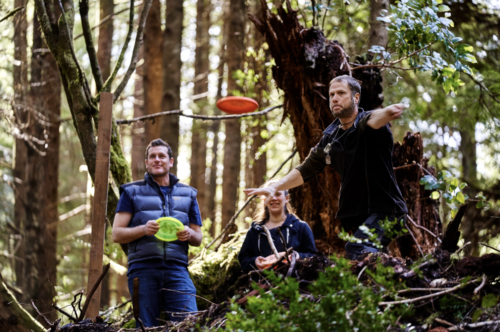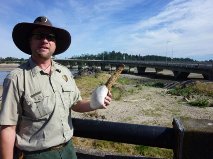State Ranger Cameron Rauenhorst, known affectionately as Ranger Clameron, grins as he holds up a BIG shell. A seven-inch neck protrudes from the shell and Clameron tells us that fully extended the neck can be nearly three feet long. Known as a Gaper, Horse, Horseneck, Blue, or Empire clam, this bivalve is one of the many clams that you can harvest on Oregon beaches. Clameron dug up this particular Gaper at low tide in Alsea Bay.
“Look for the show,” he tells us. The show is the oval hole left in the sand by clams at low tide. In the case of the Gaper, it is nearly two inches in diameter. Though smaller clams are found closer to the surface, the Gaper requires a serious hole—two feet deep in some cases. “Grab a small child by the feet,” says our grinning guide, “and hold him over the hole to dig the last couple of inches by hand.”
In a net bag, Clameron displays the smaller hardshell clams he dug that morning. Butter clams, cockles, and littlenecks are also found in Alsea Bay. Someone asks where to dig. Turning toward the Alsea Bay Bridge, Clameron points to the Y-shaped cement supports, telling us that it is the largest Y-leg bridge in the country. In the arch between the third and fourth Y, he says, you’ll be able to dig your limit in about twenty minutes. (The limit is 20 clams per person per day, of which only 12 may be the big gapers or geoducks. See sidebar for daily limits for all shellfish)
Moving over to the seawall, Clameron explains how to bait a crab trap—chicken, fish, turkey, mink, or ghost shrimp all work well—and tosses a crab ring over the edge. If you were on the docks or a boat, you would let the ring soak for 15-20 minutes before hauling it back up. “Do it fast,” he warns, pulling the rope up hand over hand with a well-practiced motion. “If you dawdle, the crabs will crawl right out and escape.” Crab pots actually trap the crabs and can be left for up to three days.
Another option is the “crabhawk,” which you hang from the end of a fishing pole. When the crab crawls onto the screen to get the bait, there is a tug, your signal to reel in the trap, which automatically closes as soon as you start pulling it in. (Designed by Steven DeMars)
Oregon State Sport Fishing Regulations allow you to keep only male crabs—the females are laden with millions of eggs and harvesting them will jeopardize production of future crabs. Cameron demonstrates how to sex a crab: the female’s abdomen is wide, the male’s is narrow. If you need help, check it out in the pamphlet Crabbing in Oregon.
Crabs must be at least 5 ¾ inches measured in a straight line across the back immediately in front of the little bumps on the side of the crab. All females and undersized crabs must be returned to the water carefully and immediately.
Along the seawall, the ranger has lined up shovels, rakes, power tools (for cleaning the beards off mussels), and clam guns, which siphon up the clam along with sand and water, and various types of crab pots and traps. On another table is a display of Oregon Sport Fishing Regulations. A license is required for all sport fishing, clamming, and crabbing. Oregon residents pay $7 for an annual shellfish license; nonresidents pay $20.50. A three-day shellfish license is available for nonresidents for $11.50.
The clams and crabs are interesting, but what we really want to know is: how did a nice boy from the Mid-West end up showing people how to sex a crab in Oregon? Cameron Rauenhorst grew up in Minnesota, learned carpentry, then moved to Maine where he encountered his first fresh seafood, including lobsters. It was love at first bite. After several years wrecking his knees putting roofs on houses, he took off with some buddies on a Frisbee golf tour. Frisbee golf tour? Yes indeed—and there is a new 18-hole course near the community college campus in South Beach, sponsored by a recently-graduated class from the Ford Family Foundation leadership program. In 2006, he decided it was That Time—time to get a haircut and a real job. He began interviewing for positions as a ranger aide and ended up at South Beach State Park.
And then, there he was, an Interpretive Ranger showing people how to dig for clams. He hit the internet to find out all he could, but really, he says, “It was all about on-the-job training, getting dirty with the locals, finding out what the old-timers knew about harvesting wild foods.” Mike Rivers, the ranger at the Alsea Bay Bridge Interpretive Center until his retirement in May, showed him the ropes and concluded that Cameron was a natural.
He certainly loves what he does, and his enthusiasm is infectious. Makes you want to pick up a shovel and dig up some clams! Before you do that, however, Clameron advises you to call the Shellfish Hotline—1-800-448-2474. Especially in the summer months, warm ocean temperatures support an algae bloom along Oregon’s coasts and bays. This causes toxins in the muscles of shellfish to increase to dangerous levels, which can result in paralytic shellfish poisoning. The algae condition can last for a day or a month and is often localized, so you’ll want to get that up-to-date info before you dig.
At 10:30 every morning Saturday through Monday from June 15 through Labor Day, Ranger Clameron is at the Historic Alsea Bay Bridge Interpretive Center in Waldport, demonstrating how to dine al fresco in the truest sense of the words—fresh seafood that you and your family have caught. Equipment is available for rent at Dock of the Bay at the Port of Alsea. For more information on harvesting Oregon shellfish, visit the Oregon Department of Fish and Wildlife, or contact Ranger Clameron at 541-270-8480.
Sidebar:
With an Oregon Shellfish Permit, you can harvest daily:
20 Hard Shell Clams (Cockles, Butters & Gapers)
36 Soft Shell Clams (Mud & Bent-nose Macomas)
72 Purple Varnish Clams (steamers)
72 Mussels (Blue-lips)
12 Dungeness Crabs (ONLY males 5 ¾ “ of larger)
24 Red Rock Crabs (Any sex, any size)
As many Sand Shrimp (Ghost shrimp) as needed for bait to catch ocean fish
Submitted by: Andrea Scharf






